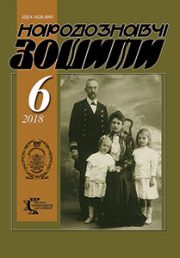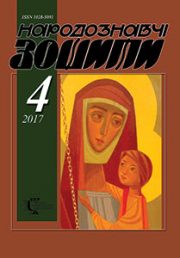The Ethnology Notebooks. 2017, 4 (136), 843–845
UDK 641.542.2032.61(477). «19/20»
DOI https://doi.org/10.15407/nz2017.04.843
POTTERS «NA OKAZIIU» IN UKRAINIAN TRADITIONAL NUTRITION CULTURE
Shcherban Olena Vasylivna, Ph.D in History, senior lecturer
at the Kharkiv State Academy of Culture
Bursatskyi uzviz, 4, Kharkiv, 61057, Ukraine,
Contacts: Tel (066) 1845061; e-mail: rector@ic.ac.kharkov.ua
Abstract. The article is about ways of clay pots usage in the traditional food culture. It was found that the production and widely used were in peak history Ukrainian traditional pottery — it was the time of manufacturing and usage of a wide range of pottery products.
Keywords: pottery, traditional food culture, zolilnyk.
Received 15.06.2017
REFERENCES
Natsional’nyj muzejzapovidnyk ukrains’koho honcharstva v Opishni, Natsional’nyj arkhiv ukrains’koho honcharstva. F. 1. Op. 7. Od. zb. 79. (Zvit pro naukovu etnohrafichnu ekspedytsiiu na Cherkaschynu (Umans’kyj rajon). 8.06.03–18.06.03 molodshykh naukovykh spivrobitnykiv Instytutu keramolohii Anatoliia ta Oleny Scherban’) [in Ukrainian].
KvitkaOsnov’ianenko, H. F. (1929). Marusia. Ukrains’ki povisti. Kyiv: Derzhavne vydavnytstvo Ukrainy. T. 1. S. 97–212 [in Ukrainian].
Lysenko, S. I. (1900). Ocherki domashnih promyslov i remesel Poltavskoj gubernii. Vyp. 2. Romenskij uezd. Odessa: Izd. Poltav. Gubernii [in Russian].
Poshyvajlo, O. (1993). Etnohrafiia ukrains’koho honcharstva: Livoberezhna Ukraina. Kyiv: Molod’ [in Ukrainian].
Poshyvajlo, O. (1993). Iliustrovanyj slovnyk narodnoi honchars’koi terminolohii Livoberezhnoi Ukrainy (Het’manschyna).. Opishne: Ukrains’ke narodoznavstvo [in Ukrainian].
Slovar’ ukrains’koi movy: v 4-kh t. (1907–1909). Za red. B. Hrinchenka. Kyiv. T. 4. S. 162 [in Ukrainian].
Scherban’, O. V. (2011). Hlynianyj horschyk u kul’turi kharchuvannia ukraintsiv (kinets’ XIX – persha polovyna XX stolittia). Keramyka: nauka y zhyzn’. Kyiv. № 1 (11).. S. 54–67 [in Ukrainian].
Shul’hina, Lidiia. (1929). Hancharstvo v s. Bubnivtsi na Podilli. Materiialy do etnolohii. Kyiv. T. II. S. 111–200 [in Ukrainian].





